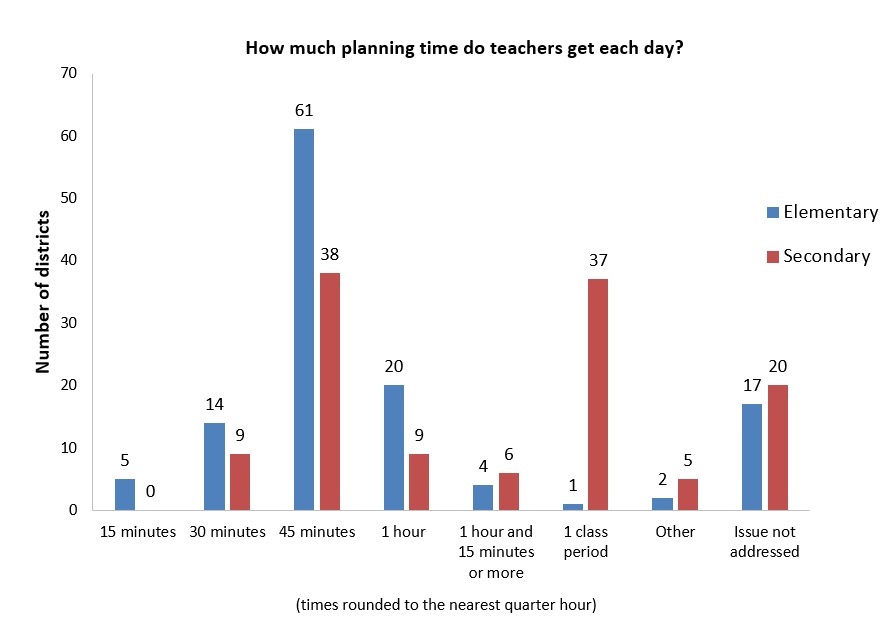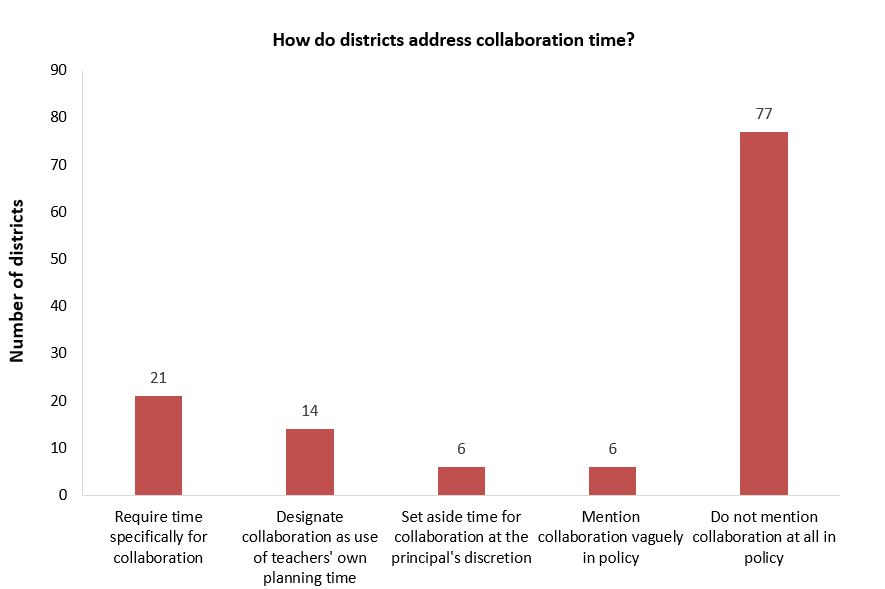District Trendline, previously known as Teacher Trendline, provides actionable research to improve district personnel policies that will strengthen the teacher workforce. Want evidence-based guidance on policies and practices that will enhance your ability to recruit, develop, and retain great teachers delivered right to your inbox each month? Subscribe here.
While salary often dominates news headlines about teacher contract negotiations, time to plan is often just as precious to teachers. Last month, the amount of time
Burlington School District (VT) puts aside each day for elementary teachers to plan was a sticking point in the district’s contract negotiations. Following a teacher strike, the district and the union came to a final agreement that included restricting the number of times elementary teachers can be assigned duties, such as lunchroom monitoring, in order to protect their planning time.
In light of how important this issue is to teachers, let’s take a look at how much time 124 large districts set aside for teachers to plan lessons, grade, collaborate, and engage in other non-teaching activities that are necessary in order to provide good instruction.
Planning Time
A teacher’s planning time is as essential to student success as the time she spends in the classroom. This year, as in
years past, districts most commonly allot 45 minutes per day at both the elementary and secondary levels.

The graph above represents the average amount of planning time teachers get each day in 124 of the largest districts in the country, although teachers may not have planning time each day. For example, in
Jordan School District (UT), elementary teachers have a 1 hour and 40 minute block of time on Fridays, but that district’s planning time is represented in the graph above as 20 minutes (rounded down to 15 minutes) per day.
Of districts whose contracts address the amount of planning time teachers are to receive,
Anne Arundel County Public Schools (MD) provides the largest amount of elementary planning time, an average of 1 hour and 22 minutes per day. A little over half of that time is reserved for individual planning time, with the rest for collaborative planning. At the other end of the spectrum, Long Beach Unified School District (CA) provides elementary teachers with a 40-minute planning block, but only on 35 days of the school year, which averages out to just eight minutes a day.
Regarding secondary planning time,
Fresno Unified School District (CA) leads the pack, providing teachers with an average of 1 hour and 36 minutes a day, whereas the Georgia districts Atlanta Public Schools and Clayton County Public Schools both only provide an average of 24 minutes per day, which is the smallest amount offered by any of the districts that address planning time.
In addition to specifying the number of minutes of planning time teachers must receive, district policies and collective bargaining agreements often put in place additional protections on planning time, spelling out not just the amount of planning time, but also how long a planning block is, how frequently teachers must have time to plan, and when during the school day schools must schedule planning time. For example, 44 percent of the districts specify the amount of elementary planning time that must be continuous, meaning a certain block of time that is uninterrupted by classes or responsibilities such as recess duty. While 56 percent of districts specify the amount of planning time elementary teachers are to receive over, for example, a one-week period, others, such as
Tucson Unified School District (AZ), drill down to the level of the school day. Additionally, some districts specify that a certain amount of a teacher’s planning time must be during the student day, rather than within the longer teacher work day. For example, Pinellas County Schools (FL) requires 30 minutes planning reserved within the student day, in addition to two hours per week outside the student day.
Collaboration Time
In addition to individual planning time, teachers need time to collaborate so they can learn from each other and coordinate within grades and subjects.
More planning time, and specifically more collaboration time, is an oft cited reason that countries like Finland and Japan outperform the United States.
That said, the majority of districts (62 percent) do not address the need for consistent collaboration time throughout the year.
Of the 47 districts that do address collaboration time, about half are clear that teachers are required to have time for collaboration, at least for some grades and/or some specified schools. The other half either explicitly state that teachers can use planning time for collaboration, provide periods of time for collaboration time at the principal’s discretion, or merely mention the importance of teacher collaboration.

Some districts are specific about the amount of collaborative planning time teachers must receive;
Fairfax County Public Schools (VA) requires that an hour per week of a teacher’s regular planning time be used for collaboration. Other districts specify how collaborative planning time is built into the schedule. For example, in Elk Grove Unified School District (CA), schools must provide either an early dismissal or a late start for students one day a week to provide teachers with time to collaborate.
Not all districts that provide collaboration time require it for all teachers. For example,
Jefferson County Public Schools (KY) dictates that teachers in their lowest achieving schools must be provided with common planning time.
While we know teachers in the United States typically have less planning and collaboration time than teachers in high achieving countries, we illustrate here that districts in the United States do not take a uniform approach to either individual or collaborative planning time.
To learn about planning and collaboration time in large districts around the country, visit the
Teacher Contract Database.
The Teacher Contract Database includes information on 147 school districts and 2 charter management organizations in the United States including: the 100 largest districts in the country, the largest district in each state, and the member districts of the Council of Great City Schools. The database features answers to over 100 policy questions and provides access to teacher contracts, salary schedules, and board policies in addition to relevant state laws governing teachers.

